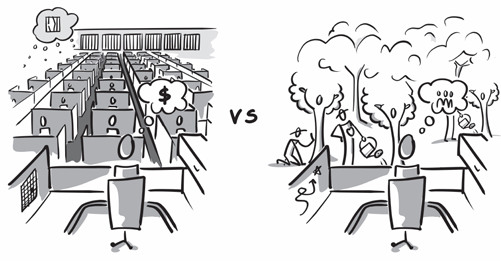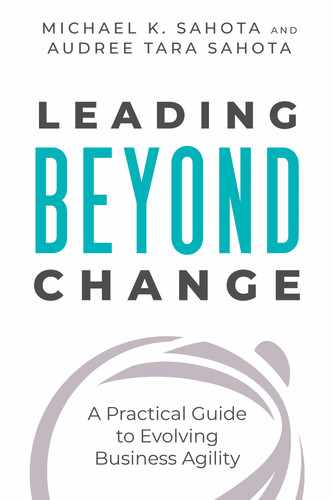15 ∎ BEYOND
Moving into the Beyond
You can’t connect the dots looking forward; you can only connect them looking backwards. So you have to trust that the dots will somehow connect in your future. You have to trust in something— your gut, destiny, life, karma, whatever. This approach has never let me down, and it has made all the difference in my life.
—Steve Jobs
From Traditional to Evolutionary
Whether you call beyond the future of work, business agility, or Teal, we invite you to a broader understanding through the term Evolutionary. We invite a holistic and integrated view of the beyond. As shown in figure 15.1, all levels of the tree, from understanding reality to results, all are deeply interconnected. (The Laws of Organizational Dynamics express the underlying connection between cause and effect.)
Now it is possible to see the connections. As leaders are able to understand and more accurately perceive external reality and inner reality, they will unlock their own Evolutionary Leadership journey to lead by example. Through this process they will learn how to navigate the paradox of power to wield the smallest possible power to let go of control, agenda, and to recognize the inherent sovereignty of every human being. It becomes about their own evolution as responsible, energized cocreators of an organizational culture that truly values people. This evolutionary shift will unlock the local adaptations required to navigate the complexity of the world to create sustained growth, performance and business agility.
Moving from Traditional to Evolutionary is a multidimensional journey. It is not possible to simplify this map. No part of this model can be abandoned as unnecessary or unimportant. Similarly, there is nothing missing: it is a complete map to navigate the evolution of high-performance organizations.
One can now understand all books, models, rules, and theories on increasing performance as speaking to one of the dimensions. Radical candor is about leadership and reality. Focus on relationships is not really about people, it is about the understanding of our reality and the reality of our leadership. Creating psychological safety is ultimately not really about the culture or people or even use of power— it’s diving into the depths of our inner reality to unlock safety in our own being.
New Ways of Working and Being
The principle “a new way of being enables a new way of working” is not a fancy slogan, it is standing in the truth of what it takes to work with new ways of working or Teal-like organizational structures. The maturity of the people and thus the organization is the key factor for high performance. A shift in consciousness enables one to “show up” with a dissolved ego, ready to be aligned in cooperation, motivation, collaboration, engagement, and intelligence. This creates an organization filled with leaders at all levels—people who have a passion and desire to create great outcomes.
We believe there is an opportunity to change the world of work—to create systems where people are motivated, happy, and operating as their best selves. The outcomes are organizations that create products and services that change society and build relationships that support the brilliance of others. We believe there is an opportunity for organizations to model high-performance cultures with new ways of working. And perhaps the new world of work will show humanity that it can overcome and reach new heights of human potential.
There is no way for people to fully embody the highly evolved new structures and new ways of working without an evolution into higher states of consciousness. The new structures and ways of working that will create high-performance organizations can be only achieved when there are behaviors that function in alignment with new ways of working.
For example, transparency of payroll throughout the system will not feel safe or be tolerated by those who function as Theory X workers, a type of thinking and behavior that comes from a lower state of consciousness. This produces resentment, jealousy, and can be the activator of behaviors such as demotivation, backstabbing, or noncooperation. Another example would be, Do you or your organization trust people? Are there open budgets and expense accounts? Do people manage their own leave days and vacation days?

Model: Organizational Culture: Traditional to Evolutionary

We can see organizational culture as a clear way to understand an organization’s journey into the Beyond. The two definitions of culture from the SHIFT314 Culture Model clarify why culture serves as a key indicator of evolutionary progress:
• Culture is the dynamic emergent cocreation of the unifying fabric of organizational reality.
• Culture is the wibbly-wobbly thing that connects everything.
Table 15.1 highlights the key indicators of a shift in organizational culture from Traditional to Evolutionary.
We offer a free survey that allows you to take a pulse on the culture of your organization by sensing various factors that lead to organizational performance. You can access the survey here: https://www.comparativeagility.com/capabilities/organizational-performance-assessment/.
Table 15.1: Organizational Culture: From Traditional to Evolutionary
| Belief/Topic | Traditional | Evolutionary |
| Reality | Challenging information is ignored or denied. | Openness and curiosity to discover new information. |
| Learning | Limited learning. | Unlearning. |
| Evolution | Status quo is acceptable. | Evolution is needed for ongoing adaptation. |
| Focus | Profit first or customer first. | Employee first. |
| Management | Traditional management structures and concepts are sufficient. | The responsibility of management is to unleash people’s capabilities. |
| Employees | Theory X. Resources to be managed. | Theory Y. People are the organization. |
| Culture | Culture is an afterthought. | Culture is the basis for success. |
| Psychological safety | Fear, stress, blame, cover-ups. | Support, caring, openness, equal voice |
| Equal voice | Management controls agenda. | Everyone can contribute. |
| Engagement | Low, partial, and mixed levels. | High. It’s an important topic. |
| Development | Strengths and skills. | Personal growth. |
Your Turn
• Where do you see your organization on its journey from Traditional to Evolutionary?
• How much desire do you sense in your organization to evolve from the current organizational culture?
• What beliefs or topics are more open to discussion and growth?

